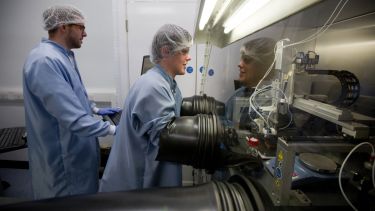Facilities
In the School of Mathematical and Physical Sciences we make sure that you have all the training and equipment you need to develop the professional skills for your discipline.

Where we are
We're based in the centre of campus, just across the road from award-winning library facilities and the UK's number one students' union, and a short walk from the city centre and our student accommodation.
The School of Mathematical and Physical Sciences spans across multiple buildings. Our chemistry students are based in the Dainton Building and the Richard Roberts Building next door. Physics and astronomy, and mathematics and statistics students are all based in the Hicks Building.
Across these locations there are plenty of lecture and small group teaching spaces, as well as labs and world-class research facilities. The Hicks Building also houses computer rooms for programming classes and the Barry Jackson common room, a social space for students.
Lecture and tutorial spaces
Your lectures will take place in lecture theatres in the School of Mathematical and Physical Sciences or close by on campus. Most of our lectures are recorded so that you can return to them later. You'll also have small group teaching sessions in our seminar rooms and staff offices, so you can look at problems more closely. You can also book meeting rooms to work on group projects with other students.
Computer facilities
Bookable computers are available in the school. There are also hundreds of computers available through the University's library services, including at the Diamond and the Information Commons, which are open to all students 24/7.
Practical spaces
Chemistry, physics and astronomy are practical subjects, so we make sure you have all the space and equipment you need to develop your practical skills.
Teaching laboratories
Chemistry students learn in three large teaching labs, one for organic chemistry, one for inorganic chemistry and one for physical chemistry. Each lab is equipped with specialist analytical equipment, including nuclear magnetic resonance, infrared and ultraviolet spectrometry, and gas- and size-exclusion chromatography.
Physics and astronomy students are trained to use essential experimental tools. This includes x-ray diffraction to measure crystal structure, gamma spectroscopy to measure radioactive materials, thermal imaging and microscopy. Our experimental spaces combine computing for automated data collection and data analysis along with a wide variety of instrumentation. You will develop the skills to build experiments from scratch to investigate electromagnetism, materials, particle, thermal and quantum physics.
Research facilities
Chemistry students in the fourth year of an MChem degree are based in one of the specialist laboratories where our academic staff work on their research. These include our advanced laser spectroscopy and small-angle X-ray scattering labs.
There are a range of research facilities available to physics and astronomy students in their third and fourth years of study. These include our specialised Quantum Information Laboratory where you can measure the behaviour of single photons in optical circuits that are the building blocks of quantum computers. Fourth year projects can be based in one of the research laboratories where professional scientists work on their research. These include facilities for testing solar devices, imaging and microscopy tools for analysing biological samples and clean room laboratories where the detectors used in CERN and other international particle physics collaborations are assembled.
Astronomy telescopes
We have two observatory domes on the lower roof of the Hicks Building that contain telescopes that are solely for undergraduate use. In addition to general lunar, planetary and deep sky imaging, typical projects include imaging of open clusters to calculate ages and distances, and lightcurves of variable stars and cataclysmic variables.
- The Hicks Telescope
-
The Hicks Telescope is a Meade 0.40m (16") LX200-ACF Schmidt-Cassegrain telescope and utilises a SBIG ST10-XME CCD camera for imaging.
This telescope is used by all second year astronomy students and can be used by third and fourth year students for project work.
A SBIG spectrograph can be attached along with the same CCD camera to perform spectroscopy instead of imaging.
- Robotic Observatory for Sheffield Astronomy (ROSA)
-
ROSA contains a Meade 0.25m (10") LX200-ACF telescope with an Atik One 6.0 CCD camera.
This telescope is used remotely by all first year students and can be used by third and fourth year students for project work. If the telescope is not needed for project work, it is freely available to all astronomy students at any time.
- Imaging capabilities
-
Both telescopes have autoguiding capability so long exposures can be taken as necessary. They also have a variety of filters that can be used for different types of astronomical observations.
Due to the advancement of CCD camera sensitivity, excellent results can be obtained from the Hicks Building roof, even though it is located close to Sheffield City Centre. Astronomical objects with V magnitudes down to 17 are usually observed and the atmospheric seeing median is 3 arcseconds.
We also work with the University of Durham to run pt5m, a 0.5m telescope at the Roque de los Muchachos Observatory on La Palma in the Canary Islands. Third and fourth year astrophysics students also have access to pt5m for projects either remotely, based in Sheffield, or during our annual observing field trip to La Palma.
